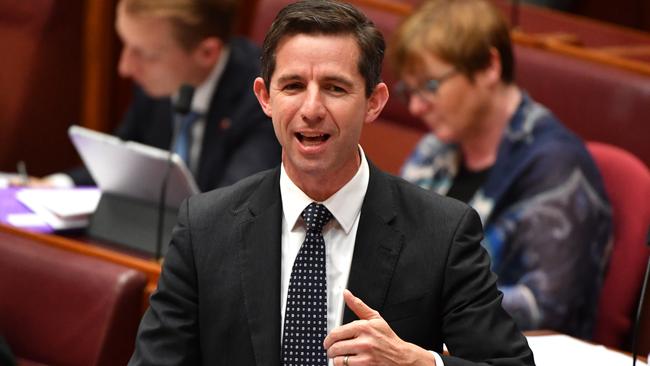Education Minister says uni cuts won’t hit fees, funding
Universities are ‘awash’ with funding, the Education Minister says, rejecting claims budget cuts will hit student numbers.

Education Minister Simon Birmingham has disputed higher education sector claims that the government’s cuts to universities will force them to trim student numbers and hit regional and low socio-economic status students hardest, saying there will be no impact on student fees and or equity funding.
The Turnbull government yesterday announced it was seeking to recoup $2.2bn in cuts which have so far failed to pass the Senate by freezing higher education funding at 2017 levels from January 1.
The government will also attempt to lower the income threshold at which graduates must begin repaying their HELP loans from the legislated $52,000 (down from the current $55,874) to $45,000 from July 1.
“There are no impacts to student fees. Every single dollar of equity funding for universities is preserved under these changes,” Senator Birmingham told ABC radio.
“What we are seeking to do is ensure that all students, all young Australians, don’t face unreasonable levels of government debt in the future, that we do continue to bring the budget back into balance.
“We’re also working to make sure that we improve student outcomes, that we make universities, who’ve enjoyed phenomenal growth in revenue over the last few years, twice the rate of economic growth since 2009, some 71 per cent lift in their income stream, making sure that they take stock with huge increase in revenue and huge increase in student numbers to make sure that they are also delivering a quality student experience and really focus on student outcomes.
“We’ve seen that increase in growth in recent years. We have sadly seen an increase in non-completions and a decrease in short-term employment outcomes for students, which really isn’t good enough.”
Senator Birmingham said university spending on advertising showed the sector had been “awash” with extra funding in recent years.
“You need only have a look at their massive advertising spend, $1.7 billion on advertising over the last few years from universities, to show that there’s plenty of cash being spent in administration, in marketing, that can deliver efficiencies to ensure they can invest in better student outcomes and continue, of course, to provide opportunities for students from all walks of life,” he said.
Senator Birmingham said any reduction in student numbers would be a choice universities made.
“Universities can choose to direct funding away from marketing and administration expenses and into areas such as more support for students and indeed more students, if they so choose,” he said.
The government has flagged performance-based funding linked to population growth after 2020.
Senator Birmingham said the government would use metrics such as “quality of student experiences, measured by attrition rates, completion rates, student satisfaction surveys, and ultimately graduate employment outcomes” to gauge performance.
He said the reduction in the HECS-HELP repayment threshold would amount to around $8 or $9 a week for graduates repaying their tertiary education costs.
“We have about $50 billion worth of student debt on the books at present and without some changes to the way the HECS-HELP scheme works, it’s estimated that around one-quarter of that may not be repaid,” Senator Birmingham said.
“We want to make sure that people can continue to go to uni without paying a dollar upfront, and in doing so, that means you have to ensure student loans are repaid, which is why there’s very modest changes proposed.”
Plibersek defends university funding growth under Labor
Labor Education spokeswoman Tanya Plibersek defended the “substantial increase” in university funding under the Rudd-Gillard government.
“In 2007 it was about $8 billion a year, by the time we left government it was $14 billion a year so we have seen substantial increases,” Ms Plibersek told Sky News.
“But those substantial increases are because there are a lot more people going to university. “There were 190,000 extra students when Labor uncapped university places and what we saw yesterday was a reversal of that policy, that used to have bipartisan support, of uncapping undergraduate places.”
Ms Plibersek said Labor defended setting targets to boost the number of people gaining bachelor degrees.
“It’s actually a good thing to be educating and skilling our workforce,” she said.
“As well as individuals missing out because of the massive cuts that the Government announced yesterday, our economy will suffer.”
Ms Plibersek said young people would be “turned away” from university as a result of yesterday’s cuts.
“The regional universities are saying it will hit the regions particularly hard,” she said.
“The technology universities are expressing their concern. It means that courses that are more expensive to teach, like nursing and engineering, where we already have skill shortages emerging, universities will be less inclined to teach those expensive-to-teach courses.”
Ms Plibersek said it was unfair to ask Australian students, who were already contributing a large proportion of the cost of their degrees by international standards to pay their HECS-HELP debts back sooner.
“You think about what’s happening when a student is graduating from university, they’re moving out of home, they’re trying to buy a house, they’re trying to start a family,” she said.
“We think the threshold is about right now. We’ve already helped the government to reduce the threshold to $52,000 a year, but taking it lower than that, well the Government haven’t made a case for that.
“Also remember, these are the same students that will be facing an increase in their Medicare levy costs, so they’re actually going to be paying more tax as well as more HECS, as well as facing a very difficult housing market, as well as trying to establish themselves as independent, moving out of the family home.
“It really feels like a war on young people when you start piling all these expenses on to young people.”
Ms Plibersek said it was unclear how the government intended to measure performance in order to link funding to performance after 2020.
“What does it even mean? I mean, this is another one of those thought-bubbles released by the Government with no detail, no ability for universities to judge how they will be judged, what they will be judged on,” she said.
“It looks to me, and to people who follow these things closely, like another excuse to cut funds to universities.
Ms Plibersek said it would be “crude” to measure performance through attrition rates.
“Of course we want people to go to university and to finish their courses, but sometimes we’re talking about people whose lives are very complicated,” she said.
“We’re talking about, for example, mothers in regional communities who take a long time to finish a university degree because their life gets in the way, they’re raising children and so on along the way.
“Should universities be punished for taking that student as a student rather than a kid fresh out of high school who’s got all the family supports and all the economic supports they need to finish university quickly?
“I think we want people who are from low-SES backgrounds, regional communities, indigenous students, we want them going to university and if Simon Birmingham’s making it harder for those people to go to university, he’s not doing them any favours, and he’s not doing our country any favours either.”




To join the conversation, please log in. Don't have an account? Register
Join the conversation, you are commenting as Logout